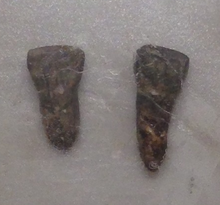Yuanmou man

As Yuanmou Man ( Homo erectus yuanmouensis , Chinese: Yuanmou Yuanren元谋猿人or Yuanmou ren元谋人), two fossil called maxillary incisors by the geologist Fang Qian in Shangnabang in the district in 1965 Yuanmou in the southern Chinese province of Yunnan were found. Because of their similarity to the Beijing man finds known from Zhoukoudian , they are - like the Jianshi man - assigned to Homo erectus .
The age of the finds is unclear, as their exact location at the site could not be reliably reconstructed during subsequent excavations in 1973 by the Institute of Vertebrate Paleontology and Paleoanthropology of the Chinese Academy of Sciences . In the vicinity of the site there are areas whose age has been dated to around 1.7 million years. Finds of fossil animals, the age of which has been dated elsewhere and is therefore considered certain, indicate that the soil layers have repeatedly been significantly rearranged, so that today older material is on top of younger and an age of less than 900,000 years can be assumed. Other estimates, which also take into account the history of the spread of Homo erectus in Asia, only assigned the finds to an age of 600,000 to 500,000 years.
The site of his discovery has been on the list of monuments of the People's Republic of China since 1982 .
Further investigation revealed that the human remains in a layer just above the Olduvai Matuyama reversal were so created (Olduvai Matuyama reversal) before at least 1.77 million years. Therefore it was concluded that the teeth found there and the surrounding artifacts were about 1.71 million years old.
See also
literature
- Zhao Guoxing et al. a .: Yuanmou ren , Kunming: Yunnan renmin chubanshe 1984.
- YM Hou, LX Zhao: An Archeological View for the Presence of Early Humans in China , in: Quaternary International 223-4 (2010) 10-19.
Web links
- chinaculture.org: Yuanmou Man Site - English
- china001.com: Yuanmouren (Jia Lanpo) - Chinese
- chinabaike.com: Yuanmou yuanren (Homo erectus yuanmouensis) - Chinese
Individual evidence
- ↑ C. Hu: Ape-man teeth from Yuanmou, Yunnan. Acta Geologica Sinica, Vol. 1, 1973, pp. 65-71
- ↑ Peter Brown : Chinese Middle Pleistocene hominids and modern human origins in east Asia. In: Lawrence Barham and Kate Robson Brown (Eds.): Human Roots. Africa and Asia in the Middle Pleistocene. Western Academic & Specialist Publishers, Bristol 2001, pp. 137-138, ISBN 978-0953541843 , full text (PDF; 3.5 MB)
- ↑ Yuanmou. (with ill.) Overview by Prof. Peter Brown, Chair of Palaeoanthropology, School of Human and Environmental Studies
- ^ Geoffrey G. Pope: Evidence on the age of the Asian Hominidae. In: PNAS , Volume 80, No. 16, 1983, pp. 4988–4992, full text (PDF; 1.1 MB)
-
^ RX Zhu et al .: Early evidence of the genus Homo in East Asia. In: Journal of Human Evolution. Volume 55, No. 6, 2008, pp. 1075-1085, doi: 10.1016 / j.jhevol.2008.08.005
Ann Gibbons: Speed-Walking Across Asia. On: sciencemag.org October 7, 2008.

